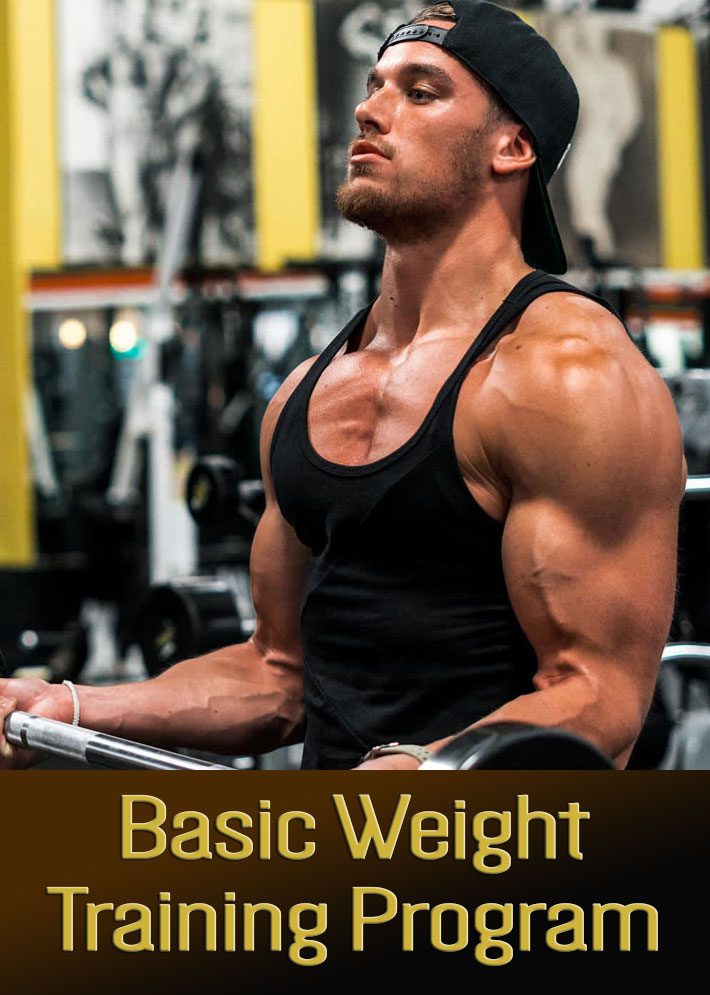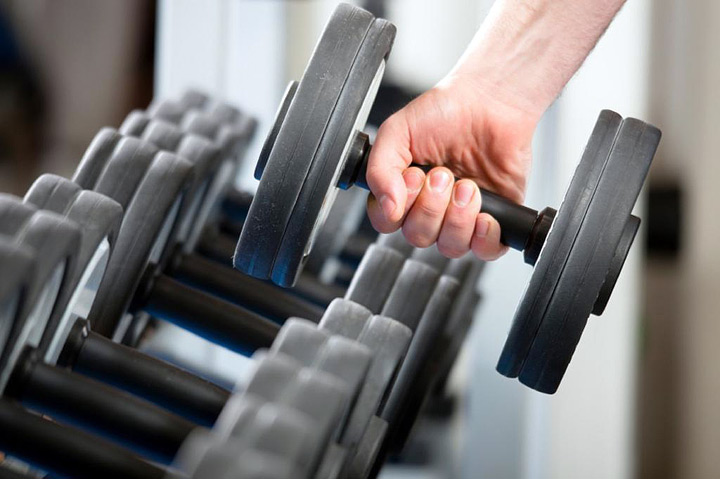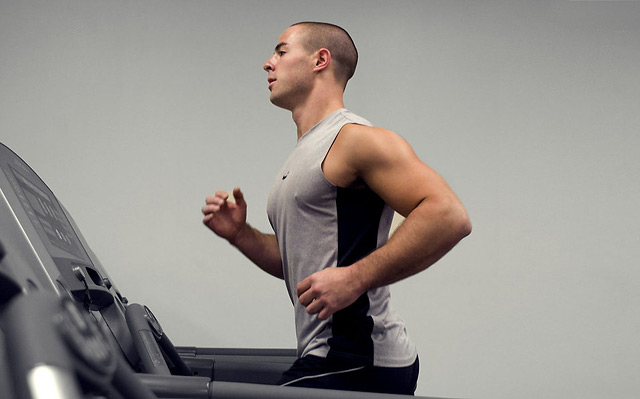
Basic Weight Training Program
The Basic Weight Training Program is not just for beginners: you should use it if you want a formalized and precise program following casual experience with weights. As the name implies, it’s an all-round program for basic strength and muscle building.
This could be used in off-season training if your sport has elements of strength, power and strength endurance, which fits many sports. Consult your coach to ensure it doesn’t conflict with other training priorities. Training programs are always most efficient when tailored specifically for individuals and their goals.
It’s worth reading the introductory weight training information before starting this program, or any program for that matter. The exercises use the standard free weights and equipment found in most gyms. All exercises can be done at home if you have the appropriate home gym equipment.
- A medical examination and clearance is wise if you’ve been sedentary for a lengthy period.
- Take care with injured or dysfunctional joints.
- Get medical advice before starting weight training if this applies to you.

The basic weight training program includes:
- Warmup
- Squat (or leg press)
- Bench press (or chest press)
- Deadlift
- Crunch
- Seated cable row
- Triceps pushdown
- Lat Pulldown
- Overhead press
- Biceps curl
- Cool down, stretch
The Warmup
Warm up with ten minutes of aerobic exercise. This can be with treadmill walking or jogging, stationary bicycle, cross-trainer or stepper machines. Extend this to 30 minutes depending on requirements for fat loss.
In any case, I recommend at least 30 minutes of cardio exercise at moderate intensity three times each week for all weight trainers in order to promote aerobic fitness. It need not be done at the same time as the weights session.

Warmups are important to get blood flowing to heart, lung and muscles and lubricating (synovial) fluid loosening the joints ready for action. Each weights exercise should include a warmup with light weights and practising the same form as for the workout weight. Sixty percent of your workout weight is about right for warmups. Stretching is not so important before exercise and is better performed after exercise. Some light stretches will do no harm.
The Exercises
If you have little experience of weight training and free weights, you may wish to start with the machine leg press instead of the squat, especially if you’re not accompanied by a trainer, helper or spotter. Even so, there is no reason to be intimidated by the squat exercise. It need not be done in a squat rack or power cage with the big bar and free weights to begin with, although squatting with the bar alone is a good way to practice form.
Dumbbells or small-bar barbells or a Smith machine can provide reassurance for the beginner. The same applies to the racked bench press with heavy bar, which can be substituted with dumbbells or lighter barbells. The key is not to lift too heavy too soon.
Sets, Repetitions and Starting Weight
You will start with 1 set of 12 repetitions for each of 9 exercises for the first week. At workout session 8, you should have progressed to 3 sets of 12 repetitions for each exercise. The weight you choose to start with will be sufficient to perform a set of 12 repetitions to failure with good form, which means that the twelfth repetition is pretty much the most you can do without resting. This is called 12RM (repetition maximum).
Various formulae exist for calculating what this starting weight should be, but I find it just as easy to trial different weights until you get to that limit. If you’re new to fee weights, this helps familiarization as well. Try an obvious light weight, for you, to warm up and then upgrade to something heavier for the workout set. By the third set you should have settled on the 12RM weight. If not, just move on and upgrade the weight next session.
The rest period between sets is variable according to your goals. For strength rather than muscle size (hypertrophy), longer rests are required – preferably about two minutes or more. For hypertrophy and elements of muscle endurance, shorter rest usually works best – around 45-90 seconds. Considering that this program is designed for a combination of strength and muscle building, you will rest for one minute if possible. Longer rests between sets are sometimes problematic in busy gyms but a longer interval than one minute is fine if that’s what you require to continue.

When you see something like: Squat: 150x3x12, 60 seconds, it means 150 pounds (or kilograms depending on the source) for 3 sets of 12 repetitions with 60 seconds rest in between sets.
Frequency of Workout
Basic weight training program is designed for 3 workout sessions each week for 6 weeks. If you consider that 3 workouts is too much because of time or fitness constraints, try to do at least 2 sessions per week, Monday to Sunday. In either case, the sequence of progression is as follows:
This program is based around 18 sessions comprised of either 6 weeks of 3 sessions or 9 weeks of 2 sessions for 9 exercises.
Here’s how it works (sets X repetitions, seconds break, for each exercise):
- Session 1 – 1 X 12, 60 seconds
- Session 2 – 1 X 12, 60 seconds
- Session 3 – 1 X 12, 60 seconds
- Session 4 – 2 X 12, 60 seconds
- Session 5 – 2 X 12, 60 seconds
- Session 6 – 2 X 12, 60 seconds
- Session 7 – 2 X 12, 60 seconds
- Sessions 8-18 – 3 X 12, 60 seconds
After session 12, consider whether you need to increase the weight for any particular exercise. If you can comfortably do more than the RM of 12 exercises, increase the weight by a modest amount, say two pounds or a kilogram for isolation exercise muscles such as triceps and biceps, and 5 pounds or 2.5.kilograms for compound and large muscle group exercises like squats and deadlifts. When using dumbbells, this would apply to each one. Don’t increase the number of sets beyond 3 at this time.
Note the flexibility here. If you’re an experienced casual lifter starting an organized program, you may be able to kick off with 3 X 12 from the beginning.
If you are new to weights and have some fitness issues, you should start with one set and progress slowly. Doing only 1 set of 9 exercises will not take too long, perhaps only 30 minutes with warmup included. Doing an extra 20 minutes or more of cardio before or after weights would be time well spent at this stage.
Once you reach full stretch in the program, aerobic training may be better done before weights or at a separate session.
Order of Exercises
The exercise order should be maintained as above, busy gyms notwithstanding. This order has been designed with large muscle group, compound exercises first, the smaller muscle isolation exercises following and with alternating ‘push’ and ‘pull’ to achieve a session that alternates muscle groups and modes of action as much as possible to enable maximum rest and recovery of the various muscle groups. Some compromises were required. Don’t get too hung-up if you can’t achieve this sequence. It’s not always possible to access equipment when you want it in gyms. In the scheme of things it’s not fatal!

Here are some examples of compound, isolation and push and pull exercises.
Squat – compound – push
Seated cable row – compound – pull
Triceps pushdown – isolation – push
Lat pulldown – compound – pull
Overhead press – compound – push
Biceps curl – isolation – pull
How to Survive and Progress
Overload Management. The basis of strength and conditioning is progressive overload. It takes some skill to judge the point at which overload — increasingly heavier weight — is building capacity yet not making you too sore, ill or fatigued to continue. That’s why it’s very important to start slowly and build. When in doubt, take a rest, miss a session but don’t alter the program detail, the reps and sets, if you can help it. The squat and deadlift can be very taxing, so be careful not to lift too heavy for a start.
Pre and Post. Second, don’t skip the warmup and cool down. Yes, these are important for your continued health and progress. If you feel pain in any movement, don’t do it. See a doctor or therapist as soon as possible if it persists.
Diet and Nutrition. Third, eat well and keep the fluid intake appropriate for the exercise and conditions. See the Bodybuilding Diet – Maximize Your Muscle.
That’s it for Basic Weight Training Program. Novices and casual exercisers can expect a 20-40 percent increase in strength and some muscle size and muscle endurance enhancement. You could continue with this program beyond the 18 weeks by increasing the weight load as strength and capability improves. However, further progress may depend on alterations in exercise variety, frequency and timing. The next phase should be an intermediate program designed to enhance the progress you’ve already made.




Leave a Reply